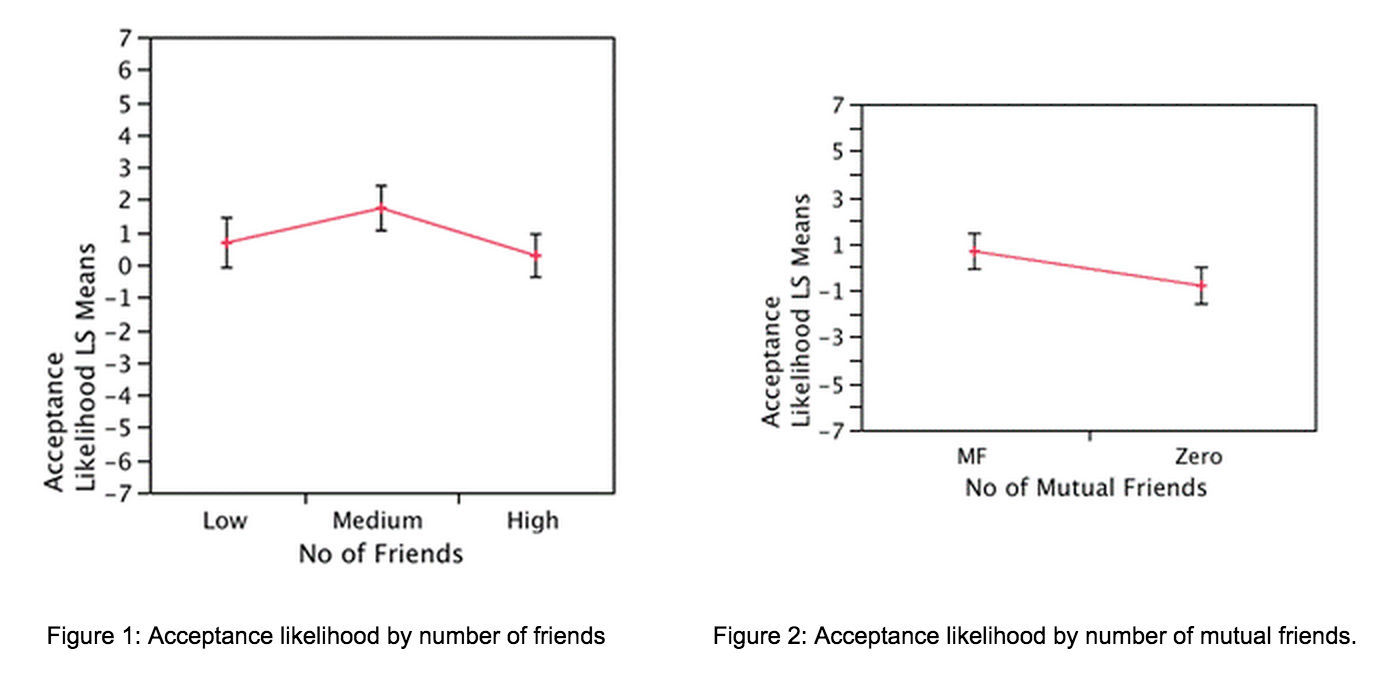Media Effects Research Lab - Research Archive
To friend or not to friend? How facebook can help me make my friend request decisions more efficient
Student Researcher(s)
Carolyn Hafernik (Ph.D Candidate);
Guan-Soon Khoo (Ph.D Candidate);
Haiyan Jia (Ph.D Candidate);
Faculty Supervisor
INTRODUCTION
Can Facebook assist users in making friend request decisions more efficiently? Our study explores how Facebook users negotiate friend requests based on psychological cues. A 3x2x2 mixed design experiment (N=246) was conducted at a large east coast university campus. We hypothesized correlations between types of friend request information (i.e. number of friends, number of mutual friends and presence of mutual interest) and acceptance likelihood, with popularity and attractiveness, common ground, compatibility, and curiosity as mediators. Our findings indicate that number of friends and number of mutual friends are significant factors for acceptance likelihood, and that curiosity is a mediator for the relationship between number of mutual friends and acceptance likelihood. The theoretical and practical implications of these relationships are discussed and recommendations for future research & Facebook design are offered.
RESEARCH QUESTION / HYPOTHESES
RQ: For Facebook users, controlling for gender, age, internet usage, Facebook usage, actual number of friends, what is the relationship between Facebook friend request cues and the acceptance of the friend request?
H1: The greater the number of Facebook friends (NOF), the greater the likelihood of acceptance.
H2: Having mutual friends (NOMF) leads to a greater likelihood of acceptance.
H3: Having mutual interests (MI) leads to a greater likelihood of acceptance.
H4: The greater the number of Facebook friends (NOF), mediated by perceived attractiveness and popularity, the greater the likelihood of acceptance.
H5: Having mutual friends (NOMF), mediated by common ground, compatibility, curiosity, leads to a greater likelihood of acceptance.
H6: Having mutual interests (MI), mediated by common ground, compatibility, curiosity, leads to a greater likelihood of acceptance.
METHOD
A 3 (number of friends) × 2 (number of mutual friends) × 2 (mutual interest) mixed-design experiment (n=246) was conducted online to test the hypotheses. The number of friends and the number of mutual friends are between-subject variables, whereas the information of mutual interest is a within-subject variable. After giving their implied consent participants viewed a friend request stimulus and filled in a questionnaire, then they looked at a second stimulus and filled in the same questionnaire again before providing some brief demographic information. The independent variables were number of friends, number of mutual friends, and mutual interests. The dependent variable was acceptance likelihood. Attractiveness, popularity, common ground, compatibility and curiosity were proposed mediators. Factor analysis revealed that attractiveness and popularity could be combined as could common ground and compatibility.
RESULTS
In sum, our results support Hypotheses 1 and 2, showing that number of friends and number of mutual friends are significant factors for acceptance likelihood (Figures 1-2).

Hypothesis 3 -that mutual interest will have a significant effect on acceptance likelihood - is not supported by the data. Hypothesis 4 is not supported by the data; while number of friends has a significant effect on popularity, popularity does not have a significant effect on acceptance likelihood. Thus popularity could not be a mediator for the relationship between number of friends and acceptance likelihood. Hypothesis 5 is partially supported as curiosity is found to be a mediator between number of mutual friends and acceptance likelihood. However, our data does not support common ground as a mediator for mutual friends. Hypothesis 6 is not supported, as common ground and curiosity are not mediators for the relationship between mutual interests and likelihood of acceptance.
CONCLUSION
Several theoretical explanations and practical issues were discussed: a ceiling effect of number of friends, heuristic versus systematic processing of Facebook friend request cues, why mutual interest did not predict acceptance likelihood, and the “social’ venue of Facebook and how this affects the usefulness of cues. In addition, design suggestions for future Facebook friend requests are presented, as are limitations of the current study and ideas for future work.
For more details regarding the study contact
Dr. S. Shyam Sundar by e-mail at sss12@psu.edu or by telephone at (814) 865-2173

